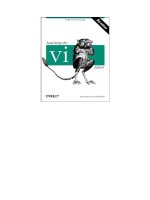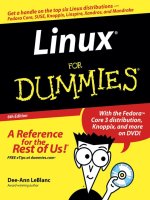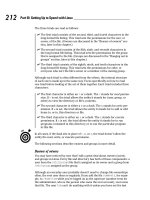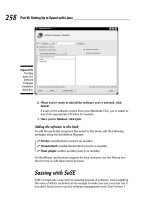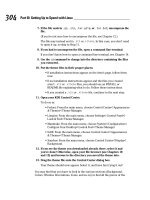Schaums outlines geometry 6th edition
Bạn đang xem bản rút gọn của tài liệu. Xem và tải ngay bản đầy đủ của tài liệu tại đây (36.56 MB, 523 trang )
Copyright © 2018 by McGraw-Hill Education. Except as permitted under the United States Copyright
Act of 1976, no part of this publication may be reproduced or distributed in any form or by any
means, or stored in a database or retrieval system, without the prior written permission of the
publisher.
ISBN: 978-1-26-001058-9
MHID: 1-26-001058-9.
The material in this eBook also appears in the print version of this title: ISBN: 978-1-26-001057-2,
MHID: 1-26-001057-0.
eBook conversion by codeMantra
Version 1.0
All trademarks are trademarks of their respective owners. Rather than put a trademark symbol after
every occurrence of a trademarked name, we use names in an editorial fashion only, and to the benefit
of the trademark owner, with no intention of infringement of the trademark. Where such designations
appear in this book, they have been printed with initial caps.
McGraw-Hill Education eBooks are available at special quantity discounts to use as premiums and
sales promotions or for use in corporate training programs. To contact a representative, please visit
the Contact Us page at www.mhprofessional.com.
BARNETT RICH held a doctor of philosophy degree (PhD) from Columbia University and a doctor
of jurisprudence (JD) from New York University. He began his professional career at Townsend
Harris Hall High School of New York City and was one of the prominent organizers of the High
School of Music and Art where he served as the Administrative Assistant. Later he taught at CUNY
and Columbia University and held the post of chairman of mathematics at Brooklyn Technical High
School for 14 years. Among his many achievements are the 6 degrees that he earned and the 23 books
that he wrote, among them Schaum’s Outlines of Elementary Algebra, Modern Elementary Algebra,
and Review of Elementary Algebra.
CHRISTOPHER THOMAS has a BS from University of Massachusetts at Amherst and a PhD from
Tufts University, both in mathematics. He first taught as a Peace Corps volunteer at the Mozano
Senior Secondary School in Ghana. Since then he has taught at Tufts University, Texas A&M
University, and the Massachusetts College of Liberal Arts. He has written Schaum’s Outline of Math
for the Liberal Arts as well as other books on calculus and trigonometry.
TERMS OF USE
This is a copyrighted work and McGraw-Hill Education and its licensors reserve all rights in and to
the work. Use of this work is subject to these terms. Except as permitted under the Copyright Act of
1976 and the right to store and retrieve one copy of the work, you may not decompile, disassemble,
reverse engineer, reproduce, modify, create derivative works based upon, transmit, distribute,
disseminate, sell, publish or sublicense the work or any part of it without McGraw-Hill Education’s
prior consent. You may use the work for your own noncommercial and personal use; any other use of
the work is strictly prohibited. Your right to use the work may be terminated if you fail to comply
with these terms.
THE WORK IS PROVIDED “AS IS.” McGRAW-HILL EDUCATION AND ITS LICENSORS
MAKE NO GUARANTEES OR WARRANTIES AS TO THE ACCURACY, ADEQUACY OR
COMPLETENESS OF OR RESULTS TO BE OBTAINED FROM USING THE WORK,
INCLUDING ANY INFORMATION THAT CAN BE ACCESSED THROUGH THE WORK VIA
HYPERLINK OR OTHERWISE, AND EXPRESSLY DISCLAIM ANY WARRANTY, EXPRESS
OR IMPLIED, INCLUDING BUT NOT LIMITED TO IMPLIED WARRANTIES OF
MERCHANTABILITY OR FITNESS FOR A PARTICULAR PURPOSE. McGraw-Hill Education
and its licensors do not warrant or guarantee that the functions contained in the work will meet your
requirements or that its operation will be uninterrupted or error free. Neither McGraw-Hill Education
nor its licensors shall be liable to you or anyone else for any inaccuracy, error or omission,
regardless of cause, in the work or for any damages resulting therefrom. McGraw-Hill Education has
no responsibility for the content of any information accessed through the work. Under no
circumstances shall McGraw-Hill Education and/or its licensors be liable for any indirect,
incidental, special, punitive, consequential or similar damages that result from the use of or inability
to use the work, even if any of them has been advised of the possibility of such damages. This
limitation of liability shall apply to any claim or cause whatsoever whether such claim or cause
arises in contract, tort or otherwise.
Preface to the First Edition
The central purpose of this book is to provide maximum help for the student and maximum service for
the teacher.
Providing Help for the Student
This book has been designed to improve the learning of geometry far beyond that of the typical and
traditional book in the subject. Students will find this text useful for these reasons:
(1) Learning Each Rule, Formula, and Principle
Each rule, formula, and principle is stated in simple language, is made to stand out in distinctive type,
is kept together with those related to it, and is clearly illustrated by examples.
(2) Learning Each Set of Solved Problems
Each set of solved problems is used to clarify and apply the more important rules and principles. The
character of each set is indicated by a title.
(3) Learning Each Set of Supplementary Problems
Each set of supplementary problems provides further application of rules and principles. A guide
number for each set refers the student to the set of related solved problems. There are more than 2000
additional related supplementary problems. Answers for the supplementary problems have been
placed in the back of the book.
(4) Integrating the Learning of Plane Geometry
The book integrates plane geometry with arithmetic, algebra, numerical trigonometry, analytic
geometry, and simple logic. To carry out this integration:
(a) A separate chapter is devoted to analytic geometry.
(b) A separate chapter includes the complete proofs of the most important theorems together with the
plan for each.
(c) A separate chapter fully explains 23 basic geometric constructions. Underlying geometric
principles are provided for the constructions, as needed.
(d) Two separate chapters on methods of proof and improvement of reasoning present the simple and
basic ideas of formal logic suitable for students at this stage.
(e) Throughout the book, algebra is emphasized as the major means of solving geometric problems
through algebraic symbolism, algebraic equations, and algebraic proof.
(5) Learning Geometry Through Self-study
The method of presentation in the book makes it ideal as a means of self-study. For able students, this
book will enable then to accomplish the work of the standard course of study in much less time. For
the less able, the presentation of numerous illustrations and solutions provides the help needed to
remedy weaknesses and overcome difficulties, and in this way keep up with the class and at the same
time gain a measure of confidence and security.
(6) Extending Plane Geometry into Solid Geometry
A separate chapter is devoted to the extension of two-dimensional plane geometry into threedimensional solid geometry. It is especially important in this day and age that the student understand
how the basic ideas of space are outgrowths of principles learned in plane geometry.
Providing Service for the Teacher
Teachers of geometry will find this text useful for these reasons:
(1) Teaching Each Chapter
Each chapter has a central unifying theme. Each chapter is divided into two to ten major subdivisions
which support its central theme. In turn, these chapter subdivisions are arranged in graded sequence
for greater teaching effectiveness.
(2) Teaching Each Chapter Subdivision
Each of the chapter subdivisions contains the problems and materials needed for a complete lesson
developing the related principles.
(3) Making Teaching More Effective Through Solved Problems
Through proper use of the solved problems, students gain greater understanding of the way in which
principles are applied in varied situations. By solving problems, mathematics is learned as it should
be learned—by doing mathematics. To ensure effective learning, solutions should be reproduced on
paper. Students should seek the why as well as the how of each step. Once students sees how a
principle is applied to a solved problem, they are then ready to extend the principle to a related
supplementary problem. Geometry is not learned through the reading of a textbook and the
memorizing of a set of formulas. Until an adequate variety of suitable problems has been solved, a
student will gain little more than a vague impression of plane geometry.
(4) Making Teaching More Effective Through Problem Assignment
The preparation of homework assignments and class assignments of problems is facilitated because
the supplementary problems in this book are related to the sets of solved problems. Greatest attention
should be given to the underlying principle and the major steps in the solution of the solved problems.
After this, the student can reproduce the solved problems and then proceed to do those supplementary
problems which are related to the solved ones.
Others Who Will Find This Text Advantageous
This book can be used profitably by others besides students and teachers. In this group we include:
(1) the parents of geometry students who wish to help their children through the use of the book’s selfstudy materials, or who may wish to refresh their own memory of geometry in order to properly help
their children; (2) the supervisor who wishes to provide enrichment materials in geometry, or who
seeks to improve teaching effectiveness in geometry; (3) the person who seeks to review geometry or
to learn it through independent self-study.
BARNETT RICH
Brooklyn Technical High School
April, 1963
Introduction
Requirements
To fully appreciate this geometry book, you must have a basic understanding of algebra. If that is what
you have really come to learn, then may I suggest you get a copy of Schaum’s Outline of College
Algebra. You will learn everything you need and more (things you don’t need to know!)
If you have come to learn geometry, it begins at Chapter one.
As for algebra, you must understand that we can talk about numbers we do not know by assigning
them variables like x, y, and A.
You must understand that variables can be combined when they are exactly the same, like x + x = 2x
and 3x2 + 11x2 = 14x2, but not when there is any difference, like 3x2y – 9xy = 3x2y – 9xy.
You should understand the deep importance of the equals sign, which indicates that two things that
appear different are actually exactly the same. If 3x = 15, then this means that 3x is just another name
for 15. If we do the same thing to both sides of an equation (add the same thing, divide both sides by
something, take a square root, etc.), then the result will still be equal.
You must know how to solve an equation like 3x + 8 = 23 by subtracting eight from both sides, 3x + 8
– 8 = 23 – 8 = 15, and then dividing both sides by 3 to get 3x/3 = 15/3 = 5. In this case, the variable
was constrained; there was only one possible value and so x would have to be 5.
You must know how to add these sorts of things together, such as (3x + 8) + (9 – x) = (3x – x) = (8 +
9) = 2x + 17. You don’t need to know that the ability to rearrange the parentheses is called
associativity and the ability to change the order is called commutativity.
You must also know how to multiply them: (3x + 8).(9 – x) = 27x – 3x2 + 72 – 8x = –3x2 + 19x + 72
Actually, you might not even need to know that.
You must also be comfortable using more than one variable at a time, such as taking an equation in
terms of y like y = x2 + 3 and rearranging the equation to put it in terms of x like y – 3 = x2. so
and thus
You should know about square roots, how
It is useful to keep in mind that
there are many irrational numbers, like
which could never be written as a neat ratio or fraction,
but only approximated with a number of decimals.
You shouldn’t be scared when there are lots of variables, either, such as
by cross-
multiplication, so
Most important of all, you should know how to take a formula like
replace values and simplify. If r = 5 cm and h = 8 cm, then
and
Contents
CHAPTER 1
Lines, Angles, and Triangles
1.1 Historical Background of Geometry
1.2 Undefined Terms of Geometry: Point, Line, and Plane
1.3 Line Segments
1.4 Circles
1.5 Angles
1.6 Triangles
1.7 Pairs of Angles
CHAPTER 2
Methods of Proof
2.1 Proof By Deductive Reasoning
2.2 Postulates (Assumptions)
2.3 Basic Angle Theorems
2.4 Determining the Hypothesis and Conclusion
2.5 Proving a Theorem
CHAPTER 3
Congruent Triangles
3.1 Congruent Triangles
3.2 Isosceles and Equilateral Triangles
CHAPTER 4
Parallel Lines, Distances, and Angle Sums
4.1 Parallel Lines
4.2 Distances
4.3 Sum of the Measures of the Angles of a Triangle
4.4 Sum of the Measures of the Angles of a Polygon
4.5 Two New Congruency Theorems
CHAPTER 5
Parallelograms, Trapezoids, Medians, and Midpoints
5.1 Trapezoids
5.2 Parallelograms
5.3 Special Parallelograms: Rectangle, Rhombus, and Square
5.4 Three or More Parallels; Medians and Midpoints
CHAPTER 6
Circles
6.1 The Circle; Circle Relationships
6.2 Tangents
6.3 Measurement of Angles and Arcs in a Circle
CHAPTER 7
Similarity
7.1 Ratios
7.2 Proportions
7.3 Proportional Segments
7.4 Similar Triangles
7.8 Mean Proportionals in a Right Triangle
7.9 Pythagorean Theorem
7.10 Special Right Triangles
CHAPTER 8
Trigonometry
8.1 Trigonometric Ratios
8.2 Angles of Elevation and Depression
CHAPTER 9
Areas
9.1 Area of a Rectangle and of a Square
9.2 Area of a Parallelogram
9.3 Area of a Triangle
9.4 Area of a Trapezoid
9.5 Area of a Rhombus
9.6 Polygons of the Same Size or Shape
9.7 Comparing Areas of Similar Polygons
CHAPTER 10 Regular Polygons and the Circle
10.1 Regular Polygons
10.2 Relationships of Segments in Regular Polygons of 3, 4, and 6 Sides
10.3 Area of a Regular Polygon
10.4 Ratios of Segments and Areas of Regular Polygons
10.5 Circumference and Area of a Circle
10.6 Length of an Arc; Area of a Sector and a Segment
10.7 Areas of Combination Figures
CHAPTER 11 Locus
11.1 Determining a Locus
11.2 Locating Points by Means of Intersecting Loci
11.3 Proving a Locus
CHAPTER 12 Analytic Geometry
12.1 Graphs
12.2 Midpoint of a Segment
12.3 Distance Between Two Points
12.4 Slope of a Line
12.5 Locus in Analytic Geometry
12.6 Areas in Analytic Geometry
12.7 Proving Theorems with Analytic Geometry
CHAPTER 13 Inequalities and Indirect Reasoning
13.1 Inequalities
13.2 Indirect Reasoning
CHAPTER 14 Improvement of Reasoning
14.1 Definitions
14.2 Deductive Reasoning in Geometry
14.3 Converse, Inverse, and Contrapositive of a Statement
14.4 Partial Converse and Partial Inverse of a Theorem
14.5 Necessary and Sufficient Conditions
CHAPTER 15 Constructions
15.1 Introduction
15.2 Duplicating Segments and Angles
15.3 Constructing Bisectors and Perpendiculars
15.4 Constructing a Triangle
15.5 Constructing Parallel Lines
15.6 Circle Constructions
15.7 Inscribing and Circumscribing Regular Polygons
15.8 Constructing Similar Triangles
CHAPTER 16 Proofs of Important Theorems
16.1 Introduction
16.2 The Proofs
CHAPTER 17 Extending Plane Geometry into Solid Geometry
17.1 Solids
17.2 Extensions to Solid Geometry
17.3 Areas of Solids: Square Measure
17.4 Volumes of Solids: Cubic Measure
CHAPTER 18 Transformations
18.1 Introduction to Transformations
18.2 Transformation Notation
18.3 Translations
18.4 Reflections
18.5 Rotations
18.6 Rigid Motions
18.7 Dihilations
CHAPTER 19 Conic Sections
19.1 The Standard Conic Sections
19.2 Ellipses
19.3 Parabolas
19.4 Hyperbolas
CHAPTER 20 Non-Euclidean Geometry
20.1 The Foundations of Geometry
20.2 The Postulates of Euclidean Geometry
20.3 The Fifth Postulate Problem
20.4 Different Geometries
Formulas for Reference
Answers to Supplementary Problems
Index
Lines, Angles, and Triangles
1.1 Historical Background of Geometry
The word geometry is derived from the Greek words geos (meaning earth) and metron (meaning
measure). The ancient Egyptians, Chinese, Babylonians, Romans, and Greeks used geometry for
surveying, navigation, astronomy, and other practical occupations.
The Greeks sought to systematize the geometric facts they knew by establishing logical reasons for
them and relationships among them. The work of men such as Thales (600 B.C.), Pythagoras (540
B.C.), Plato (390 B.C.), and Aristotle (350 B.C.) in systematizing geometric facts and principles
culminated in the geometry text Elements, written in approximately 325 B.C. by Euclid. This most
remarkable text has been in use for over 2000 years.
1.2 Undefined Terms of Geometry: Point, Line, and Plane
1.2A Point, Line, and Plane are Undefined Terms
These undefined terms underlie the definitions of all geometric terms. They can be given meanings by
way of descriptions. However, these descriptions, which follow, are not to be thought of as
definitions.
1.2B Point
A point has position only. It has no length, width, or thickness.
A point is represented by a dot. Keep in mind, however, that the dot represents a point but is not a
point, just as a dot on a map may represent a locality but is not the locality. A dot, unlike a point, has
size.
A point is designated by a capital letter next to the dot, thus point A is represented: A.
1.2C Line
A line has length but has no width or thickness.
A line may be represented by the path of a piece of chalk on the blackboard or by a stretched
rubber band.
A line is designated by the capital letters of any two of its points or by a small letter, thus:
A line may be straight, curved, or a combination of these. To understand how lines differ, think of
a line as being generated by a moving point. A straight line, such as
is generated by a
point moving always in the same direction. A curved line, such as
, is generated by a
point moving in a continuously changing direction.
Two lines intersect in a point.
A straight line is unlimited in extent. It may be extended in either direction indefinitely.
A ray is the part of a straight line beginning at a given point and extending limitlessly in one
direction:
and
designate rays.
In this book, the word line will mean “straight line” unless otherwise stated.
1.2D Surface
A surface has length and width but no thickness. It may be represented by a blackboard, a side of a
box, or the outside of a sphere; remember, however, that these are representations of a surface but are
not surfaces.
A plane surface (or plane) is a surface such that a straight line connecting any two of its points lies
entirely in it. A plane is a flat surface.
Plane geometry is the geometry of plane figures—those that may be drawn on a plane. Unless
otherwise stated, the word figure will mean “plane figure” in this book.
SOLVED PROBLEMS
1.1 Illustrating undefined terms
Point, line, and plane are undefined terms. State which of these terms is illustrated by (a) the
top of a desk; (b) a projection screen; (c) a ruler’s edge; (d) a stretched thread; (e) the tip of a
pin.
Solutions
(a) surface; (b) surface; (c) line; (d) line; (e) point.
1.3 Line Segments
A straight line segment is the part of a straight line between two of its points, including the two
points, called endpoints. It is designated by the capital letters of these points with a bar over them or
by a small letter. Thus, or r represents the straight line segment
between A and
B.
The expression straight line segment may be shortened to line segment or to segment, if the
meaning is clear. Thus,
and segment AB both mean “the straight line segment AB.”
1.3A Dividing a Line Segment into Parts
If a line segment is divided into parts:
1. The length of the whole line segment equals the sum of the lengths of its parts. Note that the length
of is designated AB. A number written beside a line segment designates its length.
2. The length of the whole line segment is greater than the length of any part.
Suppose
is divided into three parts of lengths a, b, and c; thus
. Then AB = a + b + c. Also, AB is greater than a; this may be
written as AB > a.
If a line segment is divided into two equal parts:
1. The point of division is the midpoint of the line segment.
2. A line that crosses at the midpoint is said to bisect the segment.
Because AM = MB in Fig. 1-1, M is the midpoint of and
bisects
may be shown by crossing them with the same number of strokes. Note that
crossed with a single stroke.
. Equal line segments
and
are
Fig. 1.1
3. If three points A, B, and C lie on a line, then we say they are collinear. If A, B, and C are collinear
and AB + BC = AC, then B is between A and C (see Fig. 1-2).
Fig. 1.2
1.3B Congruent Segments
Two line segments having the same length are said to be congruent. Thus, if AB = CD, then
congruent to
, written
is
SOLVED PROBLEMS
1.2 Naming line segments and points
See Fig. 1-3.
Fig. 1.3
(a) Name each line segment shown.
(b) Name the line segments that intersect at A.
(c) What other line segment can be drawn using points A, B, C, and D?
(d) Name the point of intersection of
(e) Name the point of intersection of
Solutions
(a)
,
thus,
,
,
, and
and
,
and
.
.
. These segments may also be named by interchanging the letters;
are also correct.
(b)
(c)
(d) D
(e) C
1.3 Finding lengths and points of line segments
See Fig. 1-4.
Fig. 1.4
(a) State the lengths of
(b) Name two midpoints.
(c) Name two bisectors.
(d) Name all congruent segments.
Solutions
1.4 Circles
A circle is the set of all points in a plane that are the same distance from the center. The symbol for
circle is ; for circles, . Thus, O stands for the circle whose center is O.
The circumference of a circle is the distance around the circle. It contains 360 degrees (360°).
A radius is a segment joining the center of a circle to a point on the circle (see Fig. 1-5). From the
definition of a circle, it follows that the radii of a circle are congruent. Thus,
and OC of
Fig. 1-5 are radii of O and
Fig. 1.5
A chord is a segment joining any two points on a circle. Thus, and
are chords of O.
A diameter is a chord through the center of the circle; it is the longest chord and is twice the length
of a radius.
is a diameter of O.
An arc is a continuous part of a circle. The symbol for arc is
, so that
stands for arc AB. An
arc of measure 1° is 1/360th of a circumference.
A semicircle is an arc measuring one-half of the circumference of a circle and thus contains 180°.
A diameter divides a circle into two semicircles. For example, diameter
cuts O of Fig. 1-5 into
two semicircles.
A central angle is an angle formed by two radii. Thus, the angle between radii
and
is a
central angle. A central angle measuring 1° cuts off an arc of 1°; thus, if the central angle between
and
in Fig. 1-6 is 1°, then
measures 1°.
Fig. 1.6
Congruent circles are circles having congruent radii. Thus, if
then
O≅
O′.
SOLVED PROBLEMS
1.4 Finding lines and arcs in a circle
In Fig. 1-7 find (a) OC and AB; (b) the number of degrees in
.
; (c) the number of degrees in
Fig. 1.7
Solutions
(a) Radius OC = radius OD = 12. Diameter AB = 24.
(b) Since semicircle ADB contains 180°,
contains 180° – 100° = 80°.
(c) Since semicircle ACB contains 180°,
contains 180° – 70° = 110°.
1.5 Angles
An angle is the figure formed by two rays with a common end point. The rays are the sides of the
angle, while the end point is its vertex. The symbol for angle is ∠ or
the plural is .
Thus,
are the sides of the angle shown in Fig. 1-8(a), and A is its vertex.
1.5A Naming an Angle
An angle may be named in any of the following ways:
1. With the vertex letter, if there is only one angle having this vertex, as ∠B in Fig. 1-8(b).
2. With a small letter or a number placed between the sides of the angle and near the vertex, as ∠a
or ∠1 in Fig. 1-8(c).
3. With three capital letters, such that the vertex letter is between two others, one from each side of
the angle. In Fig. 1-8(d), ∠E may be named /DEG or /GED.
Fig. 1.8
1.5B Measuring the Size of an Angle
The size of an angle depends on the extent to which one side of the angle must be rotated, or turned
about the vertex, until it meets the other side. We choose degrees to be the unit of measure for angles.
The measure of an angle is the number of degrees it contains. We will write m∠A = 60° to denote
that “angle A measures 608.”
The protractor in Fig. 1-9 shows that ∠A measures of 60°. If
were rotated about the vertex A
until it met , the amount of turn would be 60°.
In using a protractor, be sure that the vertex of the angle is at the center and that one side is along
the 0°–180° diameter.
The size of an angle does not depend on the lengths of the sides of the angle.
Fig. 1.9
The size of ∠B in Fig. 1-10 would not be changed if its sides
smaller.
and
were made larger or
Fig. 1.10
No matter how large or small a clock is, the angle formed by its hands at 3 o’clock measures 908,
as shown in Figs. 1-11 and 1-12.
Fig. 1.11
Fig. 1.12
Angles that measure less than 1° are usually represented as fractions or decimals. For example,
one-thousandth of the way around a circle is either
or 0.36°.
In some fields, such as navigation and astronomy, small angles are measured in minutes and
seconds. One degree is comprised of 60 minutes, written 1° = 60′. A minute is 60 seconds, written 1′
= 60″. In this notation, one-thousandth of a circle is 21′36″ because
1.5C Kinds of Angles
1. Acute angle: An acute angle is an angle whose measure is less than 90°.
Thus, in Fig. 1-13 a° is less than 90°; this is symbolized as a° < 90°.
Fig. 1.13
2. Right angle: A right angle is an angle that measures 90°.
Thus, in Fig. 1-14, m(rt. ∠A) ∠ 90°. The square corner denotes a right angle.
Fig. 1.14
3. Obtuse angle: An obtuse angle is an angle whose measure is more than 90° and less than 180°.
Thus, in Fig. 1-15, 90° is less than b° and b° is less than 180°; this is denoted by 90° < b° < 180°.
Fig. 1.15
4. Straight angle: A straight angle is an angle that measures 180°.
Thus, in Fig. 1-16, m(st. ∠B) = 180°. Note that the sides of a straight angle lie in the same straight
line. But do not confuse a straight angle with a straight line!
Fig. 1.16
5. Reflex angle: A reflex angle is an angle whose measure is more than 180° and less than 360°.
Thus, in Fig. 1-17, 180° is less than c° and c° is less than 360°; this is symbolized as 180° < c°<
360°.
Fig. 1.17
1.5D Additional Angle Facts
1. Congruent angles are angles that have the same number of degrees. In other words, if m∠A =
m∠B, then ∠A ≅ ∠B.
Thus, in Fig. 1-18, rt. ∠A ≅ rt. ∠B since each measures 90°.
Fig. 1.18
2. A line that bisects an angle divides it into two congruent parts.
Thus, in Fig. 1-19, if
bisects ∠A, then ∠1 ≅ ∠2. (Congruent angles may be shown by
crossing their arcs with the same number of strokes. Here the arcs of
1 and 2 are crossed by a
single stroke.)
Fig. 1.19
3. Perpendiculars are lines or rays or segments that meet at right angles.
The symbol for perpendicular is
angles 1 and 2 are formed.
; for perpendiculars,
In Fig. 1-20,
so right
Fig. 1.20
4. A perpendicular bisector of a given segment is perpendicular to the segment and bisects it.
In Fig. 1-21,
.
is the bisector of
; thus, ∠1 and ∠2 are right angles and M is the midpoint of
Fig. 1.21
SOLVED PROBLEMS
1.5 Naming an angle
Name the following angles in Fig. 1-22: (a) two obtuse angles; (b) a right angle; (c) a straight
angle; (d) an acute angle at D; (e) an acute angle at B.
Fig. 1.22
Solutions
(a) ∠ABC and ∠ADB (or ∠1). The angles may also be named by reversing the order of the
letters: ∠CBA and ∠BDA.
(b) ∠DBC
(c) ∠ADC
(d) ∠2 or ∠BDC
(e) ∠3 or ∠ABD
1.6 Adding and subtracting angles
In Fig. 1-23, find (a) m∠AOC; (b) m∠BOE; (c) the measure of obtuse ∠AOE.
Fig. 1.23
Solutions
1.7 Finding parts of angles
Find (a)
70°20′.
of the measure of a rt. ∠; (b)
of the measure of a st. ∠; (c)
of 31°; (d)
of
Solutions
1.8 Finding rotations
In a half hour, what turn or rotation is made (a) by the minute hand, and (b) by the hour hand of
a clock? What rotation is needed to turn (c) from north to southeast in a clockwise direction,
and (d) from northwest to southwest in a counterclockwise direction (see Fig. 1-24)?
Fig. 1.24
Solutions
(a) In 1 hour, a minute hand completes a full circle of 360°. Hence, in a half hour it turns
180°.
(b) In 1 hour, an hour hand turns
of 360° or 30°. Hence, in a half hour it turns 15°.
(c) Add a turn of 90° from north to east and a turn of 45° from east to southeast to get 90° +
45° = 135°.
(d) The turn from northwest to southwest is
1.9 Finding angles
Find the measure of the angle formed by the hands of the clock in Fig. 1-25, (a) at 8 o’clock;
(b) at 4:30.



